ADATA XPG SX900 (128GB) Review: Maximizing SandForce Capacity
by Kristian Vättö on June 8, 2012 1:25 AM ESTIntroduction
SandForce sets aside more NAND capacity than most controllers for spare area. While Intel, Marvell, Samsung and others default to ~7% of total NAND capacity for spare area, SandForce is almost double that. The difference boils down to RAISE, SandForce's NAND redundancy algorithm that requires the consumption of a full NAND die. The original idea was that RAISE and SandForce's DuraWrite technology could allow SSD vendors to use cheaper, less reliable NAND without any impact to the end user. It seems as though no one was willing to risk using anything but the best NAND, so we never really saw this feature exploited. A bit over a month ago, ADATA released their XPG SX900 series. It utilizes the oh-so-common SF-2281 controller but unlike other SandForce SSDs, RAISE is disabled - giving the end user more usable space.
Maximizing SandForce Capacity - How it's done
When an SSD is marketed as for example 120GB, it must have 120GB of usable space (before formatting, of course). However, the advertised capacity does not always reflect the raw NAND capacity. Both 120GB and 128GB SSDs actually have 128GiB of NAND onboard. Notice that GB and GiB are not the same. As these two are easily confused with one and another, let's revisit the topic quickly.
Giga is a prefix for billion or 10^9. That means one Gigabyte is 1,000,000,000 bytes. Gibi, on the other hand, is a prefix for 1024^3, or 2^30. Do the math and one Gibibyte works out to be 1,073,741,824 bytes. The confusing part here is that Windows uses Gibibytes for capacities but with the GB abbreviation. (As an aside, Microsoft and others have used "GB" for 2^30 some time, and "Gibibytes" and the other binary SI prefixes only came into being in 1998.) That's why we often say Gigabytes although we really mean Gibibytes. Under Windows, a 128GB SSD is actually shown as a 119GB drive, although in reality it's 119GiB.
As SSDs capacities are advertised in Gigabytes, there is always some "hidden" space thanks to Gigabyte to Gibibyte translation. A 120GB SandForce SSD has ~17.4GB or 12.7% of space that is inaccessible by the end-user. What is that space used for then? Two words: RAISE and over-provisioning.
RAISE (Redundant Array of Independent Silicon Elements) uses the capacity of one NAND die (8GiB for 2x-nm NAND) for parity data. Hence you can lose up to a full NAND package worth of data without losing anything from the user's standpoint. While RAISE is optional, all SandForce SSD manufacturers have enabled it on +120GB drives thus far. 60GB SSDs have RAISE disabled because the user accessible space would be only ~56GB with 8GiB for RAISE and ~7% for over-provisioning.
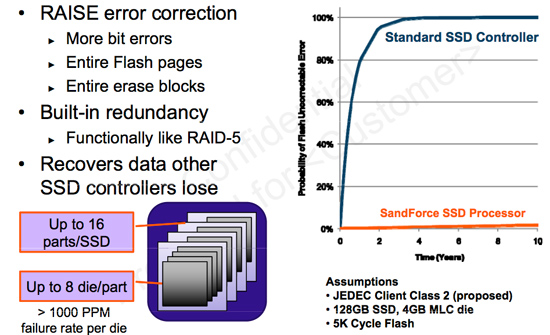
Let's illustrate this situation by looking at how the space in a 120GB SSD is used. RAISE needs a full NAND die so that's 8GiB which needs to be substracted from the raw 128GiB. We are at 120GiB now. As 120GB is user accessible space, that needs to be substracted as well, which means the space left for over-provisioning is ~8.8GB or 6.9%.
So, now we know how the space in a typical SandForce SSD is allocated, but what exactly has ADATA disabled or decreased to achieve a higher capacity? An SSD cannot work without over-provisioning because it would have no space to do garbage collection, wear leveling, and bad block replacement. 0% OP is impossible as the drive could not function if it was filled. That leaves us with RAISE. ADATA has simply disabled RAISE to gain the extra 8GiB and make 8GB of it user accessible (the remaining ~0.6GB is used for OP to keep the OP percentage the same).
And that's it. There are no extra tricks, no extra NAND onboard, and no special controller or other magic. All SF-2200 series controllers support a RAISE-disabled mode, and ADATA is simply the first one to employ it on a drive larger than 64GB. This actually brings us to the next question: What has ADATA done with the 64GB drive?
60GB SandFroce drives already have RAISE disabled because with 8GiB for RAISE and 7% for OP, the usable capacity and hence advertised size would only be 56GB. When RAISE is disabled, there is actually 12.7% left for OP on a 60GB SF drive. ADATA has simply decreased the amount of space dedicated to OP to 7%, which yields a usable capacity of 64GB (or 63.9GB to be exact).
According to SandForce, RAISE is not even necessary for consumer workloads and the built-in 55-bit BCH ECC engine should be effective enough for error correcting. Personally, I would rather lose a small proportion of capacity to prevent potential data loss, but everyone's point of view is different. In my opinion, if you need the extra capacity that one NAND package provides, then your SSD is too small to begin with. It's always a pain in the neck to deal with a drive that's nearly full, especially if it's your boot drive.
The ADATA XPG SX900
ADATA sent us a 128GB review sample. Below is the specification table for the XPG SX900 family:
| ADATA XPG SX900 Specifications | ||||
| Model | 64GB | 128GB | 256GB | 512GB |
| Raw NAND Capacity | 64GiB | 128GiB | 256GiB | 512GiB |
| User Capacity | 59.6GiB | 119.2GiB | 238.4GiB | 476.8GiB |
| Number of NAND Packages | 8 | 16 | 16 | 16 |
| Number of Die per Package | 1 | 1 | 2 | 4 |
| Sequential Read | 550MB/s | 550MB/s | 550MB/s | 540MB/s |
| Sequential Write | 510MB/s | 520MB/s | 530MB/s | 465MB/s |
| 4K Random Read | 15K IOPS | 20K IOPS | 39K IOPS | 55K IOPS |
| 4K Random Write | 87K IOPS | 88K IOPS | 90K IOPS | 47K IOPS |
| Price | $110 | $170 | $330 | $670 |
Performance is exactly what you would expect from a SF-2281 drive. RAISE does not impact performance so this is not surprising.
| Best Online Price Comparison (5/22/2012) | ||||
| 60/64GB | 120/128GB | 240/256GB | 480/512GB | |
| ADATA XPG SX900 | $90 | $160 | $300 | $610 |
| Plextor M3 | $119 | $156 | $279 | $650 |
| Crucial m4 | $80 | $129 | $220 | $535 |
| Intel 520 Series | $115 | $169 | $330 | $819 |
| Samsung 830 Series | $85 | $130 | $285 | $659 |
| OCZ Agility 3 | $70 | $120 | $210 | $500 |
| OCZ Vertex 3 | $85 | $130 | $250 | $660 |
| OCZ Vertex 4 | N/A | $140 | $290 | $640 |
| Mushkin Enhanced Chronos | $68 | $103 | $200 | $450 |
Pricing is not bad but could definitely be more competitive. The SX900 is cheaper than the Intel 520 Series while offering more capacity, but the Crucial m4, Samsung 830 Series, and OCZ Vertex 3 still beat it for most capacities. The Crucial m4 and Samsung 830 Series in particular are the two SSDs that you need to beat in order to succeed--they both offer powers-of-two capacities and seem to be very reliable, and the Samsung 830 Series in particular is also one of the fastest SSDs on the market.
I also decided to include Mushkin in the comparison because many of you have been speaking of their drives in the comments. I won't go in-depth about Mushkin right now, but the Chronos series uses a SandForce SF-2281 controller and asynchronous Micron NAND, which is very similar to OCZ's Agility 3.
It's good to keep in mind, however, that SSD prices fluctuate a lot as sales come and go. I started with the table from our Corsair Performance Pro review, but then widened our search criteria to include other online vendors; there have been plenty of changes just in the past week or so. If you are buying a new SSD, my advice would be to follow the prices for at least a few days, as you can easily save $20 or more by doing so.
As we are dealing with slightly different capacities due to the fact that most SandForce SSDs have RAISE enabled, the best way to look at this data is to compare the price per GB:
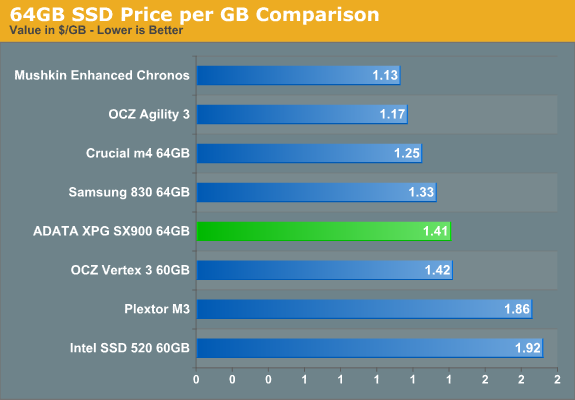
The 64GB model is in the middle of the pack in terms of pricing, basically matching the Vertex 3. The Intel SSD 520 and Plextor M3 are both substantially more expensive per GB, which is not where you want to be for a "value" capacity SSD. Given that factor, the Mushkin is currently the drive to beat for 60/64GB.
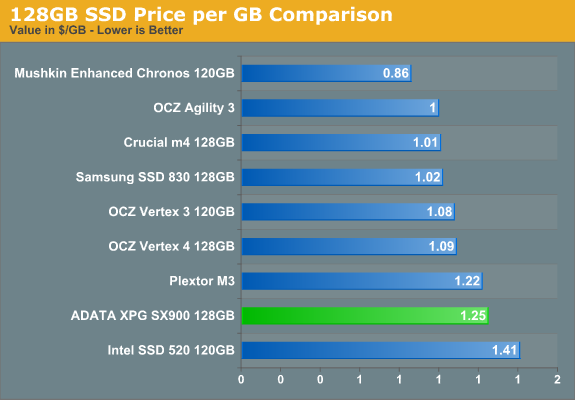
The 128GB SX900 doesn't do very well at 128GB, dropping further down our charts. Price per GB is higher than the other options--again, with the exception of the Intel 520. Even though the SX900 has 8GB more usable space, in terms of value you'd be much better off with something like the Samsung 830, Crucial m4, or the Chronos and Agility 3.
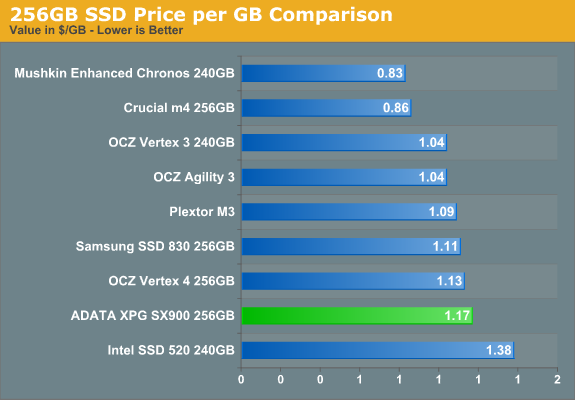
At 256GB, the trend continues with the SX900 again only offering better "value" (not taking into account firmware and reliability factors) than the Intel 520. It's only slightly more than the Vertex 4 and Samsung 830, but again we're looking at the same capacity for those two drives.
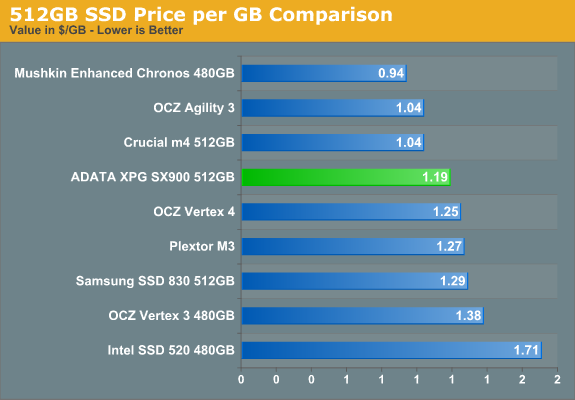
Only at 512GB does ADATA finally manage to place in the top half of our pricing charts. At these capacities, sales volume is much lower due to the overall high pricing, but outside of the Agility 3 and Chronos (which use slightly slower asynchronous NAND), the SX900 is the least expensive SF-2281 based high capacity SSD.
The drive comes with compact packaging. There is a 3.5" desktop bracket included along with mounting screws and a quick installation guide. There is no software CD included but ADATA offers a free Acronis True Image HD download, which is a handy backup/cloning utility. The 3-year warranty that ADATA gives is pretty standard for an SSD, but it could be better as for example Intel and Plextor offer 5-year warranties. The front side of the drive is covered by a big sticker that has ADATA's logo, the model number, and the capacity of the drive.
When we take the drive apart and see what's inside, there's not much out of the ordinary. There are only four screws keeping the whole package in place. It's not unheard of but the typical approach is to screw the PCB on the bottom part of the chassis and then screw the bottom part of the chassis to the top part.
On the actual PCB, there are sixteen 25nm Intel MLC ONFi 2.x (synchronous) NAND devices, eight on each side. Since this is a 128GB drive, it means all NAND devices consist of a single 8GiB die. As expected, the controller is SF-2281.
The Test
| CPU |
Intel Core i5-2500K running at 3.3GHz (Turbo and EIST enabled) |
| Motherboard |
AsRock Z68 Pro3 |
| Chipset |
Intel Z68 |
| Chipset Drivers |
Intel 9.1.1.1015 + Intel RST 10.2 |
| Memory | G.Skill RipjawsX DDR3-1600 2 x 4GB (9-9-9-24) |
| Video Card |
XFX AMD Radeon HD 6850 XXX (800MHz core clock; 4.2GHz GDDR5 effective) |
| Video Drivers | AMD Catalyst 10.1 |
| Desktop Resolution | 1920 x 1080 |
| OS | Windows 7 x64 |


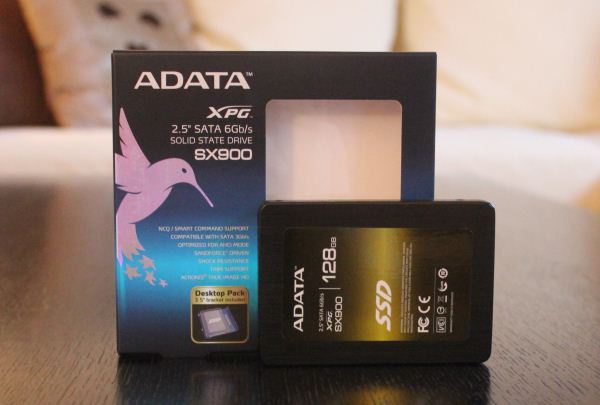
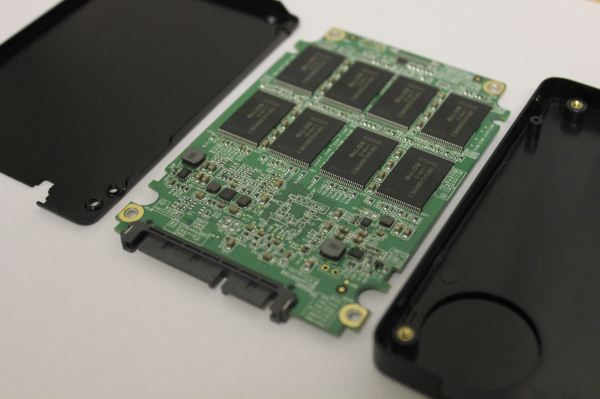
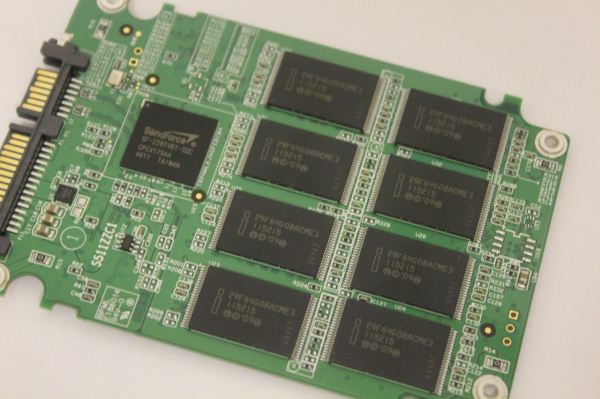








58 Comments
View All Comments
Kristian Vättö - Monday, June 11, 2012 - link
TheJian,Reading your comments actually got me interested in the whole situation. It's kind of odd to see increasing profits given that the companies were "struggling" due to floods just a few months ago. A quick conclusion would be that the HD market was getting too low-profit now that SSDs are becoming more and more popular, so the HD companies decided to blame the floods and use that as a tool to limit supply temporarily and increase prices.
I'll talk to Anand and see what he thinks. This is definitely an intriguing topic - maybe the HD companies are just ripping people off?
TheJian - Wednesday, June 13, 2012 - link
In my opinion, based on the numbers, that isn't really a question. It's a REALITY. There is NO other way to look at it. Hopefully Anand will come to the same conclusion and post an article about it. I see Dailytech picked up the article I referenced and posed it (shame...LOL - At least it wasn't Mick...). I was going to just paste my stuff onto that post from the 11th, but I didn't want to give them more hits for whoring out my post...ROFL). I don't want to see that crap repeated, I wanted it TORN APART! :)Instead of excusing them, the post should have discussed why they are getting rich during a supposed catastrophe. That is what needs to be analyzed. Why do they continue to rip retail users off? None of us signed some contract thinking no drives would be available. So why am I forced to pay a higher fee? Just to make Dell/HP feel better about getting ripped off?
PRODUCTION is in full swing at both WD and Seagate. This quarter is the first they will exceed pre-flood drive sales. Then why am I still be screwed at the store? Why did Externals NEVER go up? The same thing should be true at retail/newegg/amazon etc...Those prices have no reason to be high now with production about to EXCEED pre-flood production. What catastrophe are we in now? Is there another LARGER flood I'm unaware of that continues to hurt drive pricing? It seems completely made up at this point, when looking at the profits they are raking in (RECORD PROFITS!). Just tell Anand to look at their profits for Sept 2011 (pre flood), Dec2011 (the actual damage quarter) and 1st quarter 2012 (the complete RIPOFF quarter). I'd like to see another follow up next month or so when we get the June quarter's numbers as they will show HUGE profits for both no doubt.
Thanks for looking into it! :)
jwilliams4200 - Wednesday, June 13, 2012 - link
Actually, there is another way to look at it -- basic economics, supply and demand.The flood caused a "supply shock" (look it up on wikipedia), reducing the overall number of HDDs that could be supplied to consumers. As a result, the market price adjusted sharply higher in order to reduce demand to the amount that could be supplied. That is basic ECON 101 behavior, and not at all mysterious.
WD's production was cut sharply by the flood, but Seagate's production was not as badly impacted, as some of your figures show. But since WD HDDs and Seagate HDDs are "substitute goods" (wikipedia it), the supply curves are closely linked. So Seagate did indeed profit from the overall reduced supply, since WD lost more production. Again, this is all basic economics, and nothing nefarious is needed to explain it.
Now that production has nearly returned to pre-flood levels, there is still reason for prices to be higher than before -- pent-up demand. Many consumers have delayed HDD purchases while waiting for prices to come down. As these consumers begin to reenter the HDD market, demand will be higher than it ordinarily would be, and so the price must adjust higher than it would ordinarily be so that supply can meet demand.
All of these issues are well understood by economists. They are so well understood that they are all taught in introductory economics courses.
There is one more issue that is not basic economics, but I think it is relevant. Others may argue with me about it, since unlike the above concepts, it is not basic economics. The issue is that I think the HDD industry was not long-term viable at the prices that we saw in early-Fall 2011. Clearly the industry was not profitable enough for Hitachi or Samsung to want to continue producing HDDs. Hitachi and particularly Samsung are huge corporations which produce many products and have immense resources. If they did not think it was worthwhile to allocate their capital for HDDs in the future, then it seems obvious that the HDD industry was in severe decline.
Therefore, I think somewhat higher prices (than we saw in Fall-2011) are necessary for the HDD industry to be lively going forward. Without a prosperous HDD industry, no one will invest the billions of dollars that are necessary to develop the next generations of HDD technology. So I am actually not disturbed to see prices moderately higher than they were in Fall 2011. I expect the price per GB to start falling again eventually, but I also want to see 5TB and 8TB HDDs in the near future, and I am willing to pay a little more $/GB for that new technology.
CeriseCogburn - Wednesday, June 13, 2012 - link
A mrono can understand the issues, the problem is locked in contracts from the big system producers at elevated prices and no relief form the manufacturers.In the end any excuse is eliminated by merely seagate and wd reducing prices, which they very well can, and still retain enormous profit they never expected.
Instead they will keep the inflated contract prices and scarf the hundreds of millions.
TheJian - Monday, June 11, 2012 - link
http://www.pcmag.com/article2/0,2817,2405500,00.as...One more regarding the duopoly that they've created now (these two control 86% of the market post mergers), and having pricing power to keep them artificially high. June 7th.
jwilliams4200 - Wednesday, June 13, 2012 - link
What a terrible article! It amazes me that they failed to mention "Toshiba" at all.One of the conditions that government regulators put on the WD acquisition of Hitachi GST is that there must be a third 3.5" HDD producer with at least 20% market share (that number came from Hitachi GST's 3.5" HDD market share).
So, WD sold Toshiba IP and production facilities to allow Toshiba to produce 3.5" HDDs. I don't know all the details, but it seems likely that WD basically sold Hitachi GST's 3.5" HDD business to Toshiba. Toshiba also sold their Thailand 2.5" HDD business to WD. I don't know the details of the deal, it may have been primarily a swap rather than a cash transaction. Or not.
The situation is further complicated by all the regulators involved -- China, US, Europe. I believe China required that Hitachi GST continue producing HDDs for an extended period before the acquisition could be completed. Also, I believe the WD/Toshiba deal involved WD/Hitachi GST producing HDDs for Toshiba for some period of time.
As you can see, it is all very complicated. But the author of that article seems remarkably ignorant of the details of the situation.
CeriseCogburn - Wednesday, June 13, 2012 - link
What becomes clear is the governments of the world control production.Communism, fascism, or regulation, what's the difference - it's not working and prices are still crazy.
The pols get their due payola.
mgl888 - Saturday, June 9, 2012 - link
Anand = A NANDMind=blown